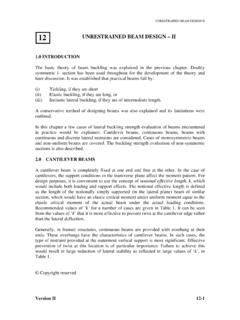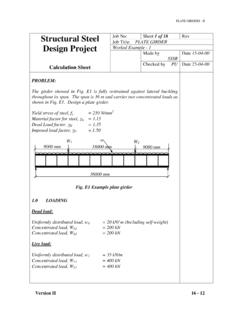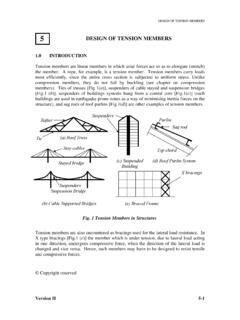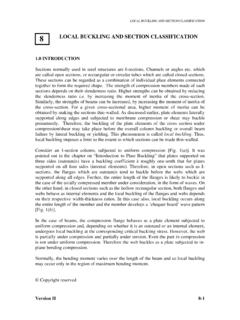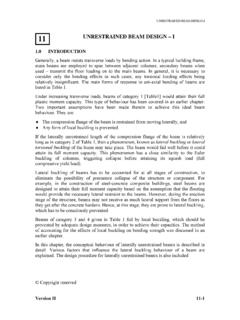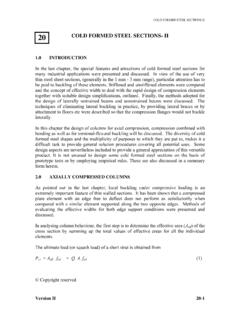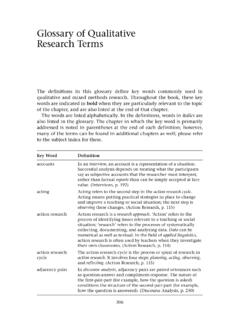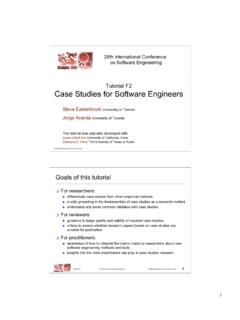Transcription of LEARNING FROM FAILURES: CASE STUDIES
1 LEARNING FROM FAILURES: case STUDIES Version II 42 - {PAGE } LEARNING FROM FAILURES: case STUDIES INTRODUCTION In pre-industrial societies, once a craft-based technique or thumb-rule for design was judged adequate for building an artefact, it was not considered necessary to develop it any further. The methods of design of buildings in those societies changed very slowly over time. Nevertheless, medieval society was indeed developing although at a relatively slow pace, leading eventually to the construction and erection of large and visible structures.
2 Generally, these buildings symbolised the greatness or valour of a particular emperor or the glory of a particular God or religion. The impressive temples built by the great Chola or Pandia Kings in South India or the great Gothic Churches and Cathedrals in Europe (particularly in Italy) are excellent examples, which are impressive even by today s standards. The enhanced functional requirements of such buildings have continued to challenge the designers and technological pressures have continued to grow. For example, there has been an increasing demand to achieve the longest possible spans and the greatest possible heights in most prestigious buildings.
3 In their desire to meet their clients or patrons needs, the designers did sometimes stray beyond the limits of contemporary technology and buildings and cathedrals collapsed as a consequence. This was the case with Beauvais Cathedral, which when built - was considered to be the most daring achievement in Gothic Architecture. When its roof collapsed in 1284, its restoration consisted of using tie rods of iron to hold the Gothic arches together, suggesting that the original designers had clearly over-reached themselves in the design of arches.
4 (As is well known, arches are mainly compression structures, and develop horizontal thrust under purely vertical loads. We need sturdy supports to resist these thrusts. Clearly, there was design error in this case ). New developments in design are often the direct consequence of lessons learnt from previous failures, which are caused when the designers went too far beyond the state-of-the art or the contractors did not implement the design intent in the construction. The development of scientific methods and reasoning, which started in the 17th century, led to the ability to predict the forces to which a structure might be subjected.
5 This led to the ability to validate structural designs at least to some extent in advance of construction. The process of industrialisation of societies also ensured the production of new materials whose properties could be predicted (unlike the natural materials - like stone - which they replaced). This combined with increase in knowledge and development of new materials actually led to the occurrence of more failures, principally as a result of enhanced demand for many types of novel structures for which there were no historical precedents, (for example, railway bridges).
6 Copyright reserved 42 LEARNING FROM FAILURES: case STUDIES Version II 42 - {PAGE } THE NEED FOR FORENSIC STUDIES Post mortem is an exact science. By employing it, we can establish the illness, which caused the death of the patient with a high degree of certainty. Many advances in Medical Sciences have been made possible by a systematic compilation of the results of post-mortem STUDIES . Engineering Designers, on the other hand, have been reluctant to reflect openly upon the causes of design failures, thus denying themselves and the profession an opportunity to understand the limitations of the particular design concept and improve the methodology.
7 For example, by 1840 the British Engineers had simply abandoned the design development of suspension bridges, following the collapse of Menai Strait Bridge and suspension structures at Brighton Pier. All these failed in high winds, due to inadequate stiffening of the decks, a deficiency not recognised by the designers at the time. Rather than interpreting the failures as an indictment of the form chosen, a contemporary American Engineer John Roebling collected case STUDIES and established the forces - not hitherto considered - which must be designed against in order to build a successful suspension bridge.
8 This resuscitated the suspension bridge technology. The famous English bridge-builder, Robert Stephenson, whose design of a Trussed Girder for Dee Bridge failed because of a very low factor of safety, was no doubt embarrassed but was candid enough to admit that nothing was so instructive to the younger members of the profession, as the records of the accidents in large works and the means employed in repairing the damage . There were indeed plenty of bridge failures both in the and in Great Britain during the latter half of 19th century and much discussion of the catastrophic failures did, in fact, take place.
9 These influenced the design development of a number of new forms of the bridges. The cantilever bridge across the Firth of Forth (the Forth Bridge) designed by Benjamin Baker is a good example of this new development and was adopted by several bridge builders the world over. An editorial titled The neering News (1887) noted that .. There is no Engineer who, if he will look back upon the past and be honest with himself will not find that his most valuable and most effective instruction has come from his own Structures which fail are the only ones which are really instructive, for those which stand do not in themselves reveal whether they are well designed or so overly designed as to be wasteful of materials and The natural impulse of those who are in anyway responsible for to keep the matter as quiet as possible.
10 Something not difficult to do in cases where there is no great catastrophe or loss of life . It is clear that much can be learned through the failure of a structure rather than a study of structures, which are successful. The proper appreciation of the causes of failure helps us to refocus on our conceptual understanding of structural behaviour. We could then assess our analytical models, which are essential for successful design practice, and help us to exercise proper engineering judgement. LEARNING FROM FAILURES: case STUDIES Version II 42 - {PAGE } Many design decisions are inevitably based on engineering judgement, which does not merely come from an understanding of theory or a powerful command of computational tools.
